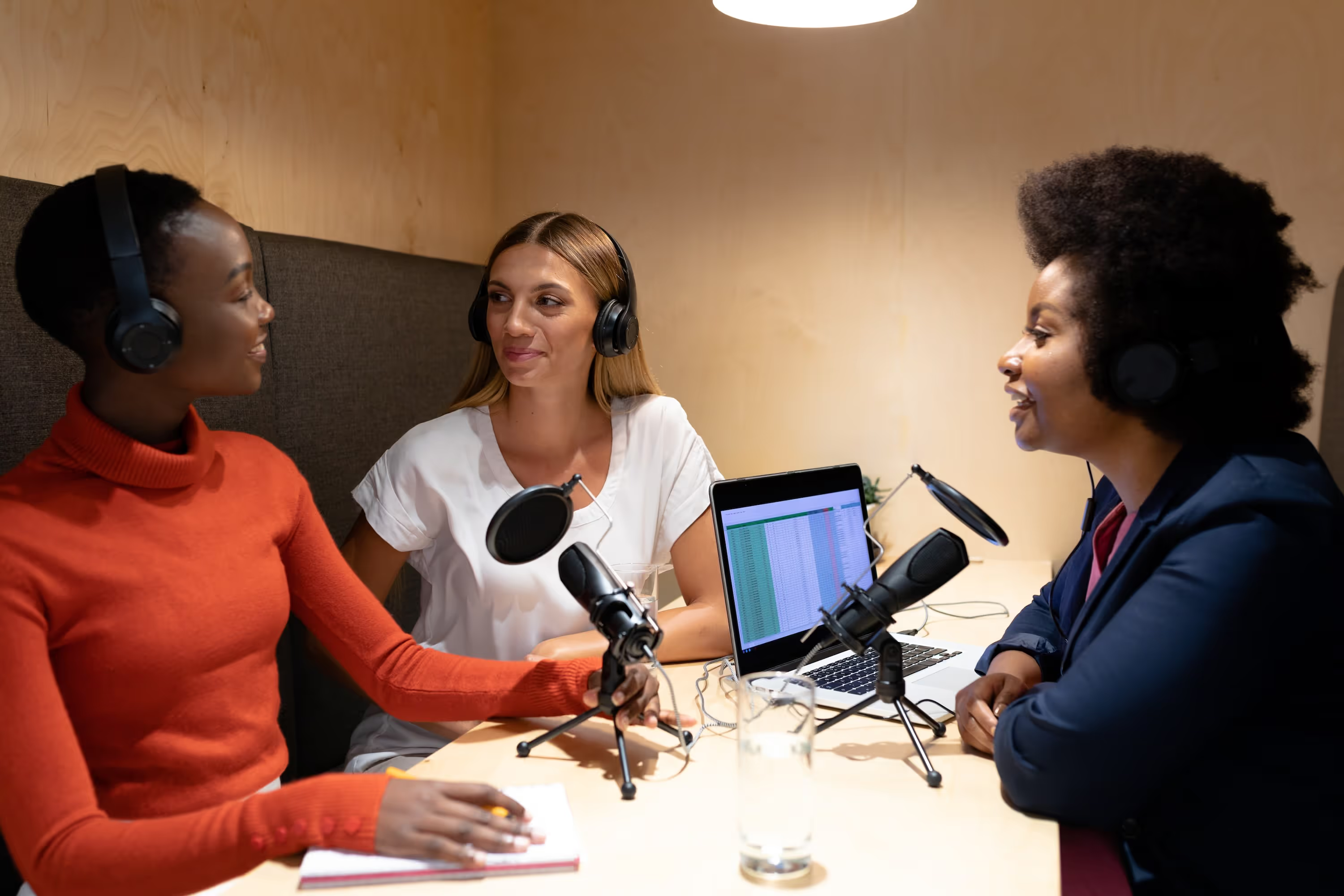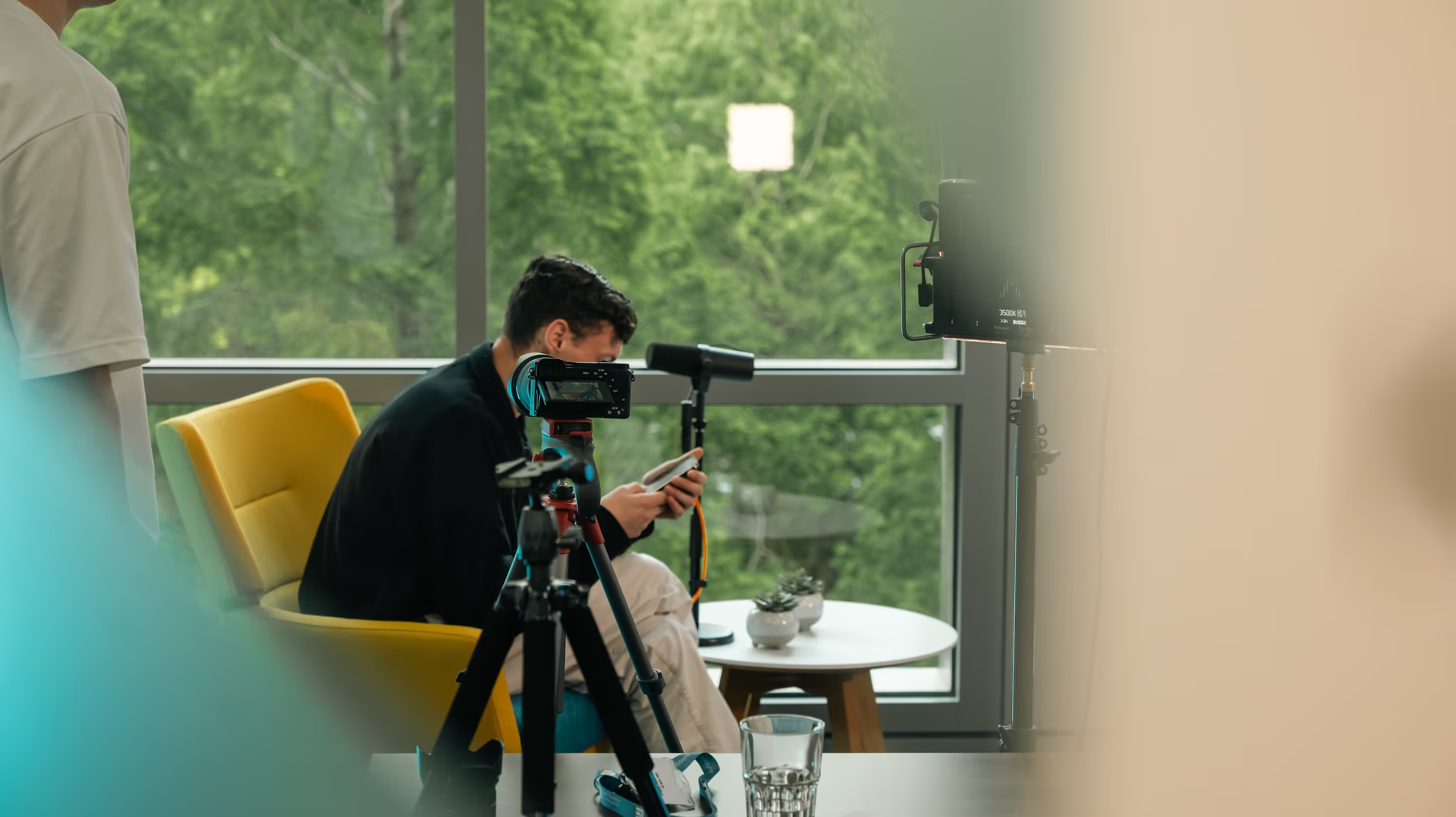
Let's Talk
Menu

A podcast without a story is like a road trip without a map. You might eventually get somewhere, but most people will jump out long before you arrive.
That’s the difference storytelling makes. It gives your episode shape, momentum, and a reason to keep listening. Whether you’re hosting a narrative series, interviewing guests, or producing a branded show, the story is what turns a good idea into something people remember.
You don’t need to be a journalist or a screenwriter. You just need to know how to shape what you already have into something that moves, and that’s exactly what this guide will help you do.
People might hit play to learn something, but they stick around when a story captivates them. Whether it’s a founder’s journey, a turning point in someone’s life, or a host opening up about a challenge, stories make content feel more relatable and human. They give listeners a reason to care.
Storytelling also gives your episodes structure. Instead of jumping from point to point, a story creates momentum. It builds tension, adds emotion, and ends with a payoff that’s easy to remember.
And when your content resonates, it moves people to take action. They share the episode. They reach out. They buy in. Because they don’t just understand your message — they feel it.

No matter what kind of podcast you're creating, great stories don't just happen, you build them. These six elements can make or break how your story lands.
At the core of any strong episode is structure. The best stories follow a clear arc: a beginning that sets the scene, a middle where something shifts, and an end that lands with insight. What makes that arc work is tension, something needs to be at stake. Whether it's a question, a conflict, or a moment of uncertainty, the story moves because something needs to be resolved.
This is easily seen in true crime or documentary podcasts, where the narrative takes the lead. But structure matters just as much in business or talk show formats. If you're interviewing a founder, start with a challenge, walk through how they navigated it, and end with what they learned. That turns a conversation into a story.
Even unscripted shows benefit from this approach. By building around a central theme and drawing out moments of change or emotion, you create shape. And when listeners can follow that shape, they stay engaged. They connect with stories of risk or breakthrough far more than a string of facts or tips.
Every good story needs someone to care about. Whether it’s the host, a guest, or someone being profiled, listeners want to understand who this person is, what drives them, and what they’re up against.
That doesn’t mean you need a full biography. It means revealing small details that make the person feel real; their motivations, fears, quirks, or turning points. The goal is to move beyond surface-level facts and into something more human.
For example, instead of just saying a guest launched a business, dig into why they did it. What pushed them to start? What did they risk? What surprised them along the way? When listeners connect with a person, they stay with the story. They want to know what happens next.
Emotion gives a story weight. It turns passive listening into something personal. Whether it’s frustration, relief, excitement, or fear, the right emotional moment makes people lean in. They care about what happens next.
You don’t need to aim for drama. Sometimes the most powerful moments are subtle, like a pause before someone answers, the crack in their voice, or a quiet confession that catches you off guard. These are the moments that make listeners lean in.
To elicit emotions, ask better questions. Go deeper than the surface story. What was the most challenging part? What did that moment feel like? What changed after that? Emotion builds connection, and connection builds trust.
Listeners can tell when something feels off. The best podcasts sound natural and grounded. That doesn’t mean skipping prep. It means showing up as yourself and allowing real moments to happen.
Authenticity makes your podcast more relatable. When a host shares something personal or admits they are still figuring things out, it shifts the tone. The conversation feels honest, not rehearsed. The same goes for guests. What matters is not saying the perfect thing but saying something true.
You are not there to perform. You are there to have an honest conversation that people can believe in.
Pacing is the speed at which a story moves. It’s how long you spend on each moment, and how smoothly you transition from one idea to the next. It affects how engaged your listener feels from start to finish.
Strong pacing keeps the story moving without rushing it. You slow down for moments that matter, speed up when the details aren’t as necessary, and cut anything that doesn’t serve the story. If the pacing is off, even a great story can feel tedious or confusing.
It matters because attention spans are short. If you don’t guide your listener through the story with intention, they will likely zone out or lose focus. Good pacing helps your content feel sharp, focused, and worth staying for.
Sound design is the art of creating atmosphere. It includes music, effects, ambient noise, and even intentional silence. Like pacing, it shapes how a story feels and how listeners experience each moment.
The right sound can make people feel something before the words even land. Think about the music from Jaws. The second you hear those low, pulsing notes, you feel tension. Nothing has happened yet, but you are already on edge. That is the power of sound. It evokes emotion, signals change, and brings the story to life.
You do not need a full score or a library of effects. Start small. Use music to open and close the episode, or to mark a shift in topic or tone. Add ambient sound to ground a scene. Use silence to let emotional moments breathe. And make sure the levels are clean. If your guest is pouring their heart out, but the background music is too loud, the impact is gone.
Sound design is not about adding noise. It is about adding meaning. When used well, it makes your story feel intentional and your podcast sound professional.
Editing is where your story takes shape. It is not just about cutting out mistakes. It is about tightening structure, improving flow, and making sure every moment earns its place in the episode.
A strong edit can turn an average conversation into a focused narrative. It removes tangents, clarifies ideas, and builds momentum. It also gives you the chance to shape the emotional arc — where the story slows down, where it speeds up, and where it lands hardest.
You do not have to over-edit. Cutting too much can make an episode feel cold or rushed. But clever editing helps your story stay sharp. It respects your listener’s time and attention. And it makes sure the message comes through clearly, without getting lost in the noise.

Now that we’ve covered the key elements of storytelling, let’s look at how they show up in the wild. These six formats use story in different ways, but all rely on structure, emotion, and clarity to keep listeners hooked.
This is the most classic form of podcast storytelling. It’s deeply reported, highly structured, and fully produced with voiceover, interviews, archival tape, and music. The host acts as a guide, walking listeners through the story beat by beat, often with suspense or twists along the way.
Think of shows like Serial, S-Town, or Resistance. These podcasts build tension, reveal new information at the right moment, and keep listeners coming back. They feel cinematic because every element is intentional, from the writing to the sound design.
They require a lot of research and editing, but when done right, they pull people in and keep them hooked from episode one.
Like narrative nonfiction, this format uses structure, pacing, and immersive sound, but the story is entirely scripted. Fiction podcasts rely on voice acting, dialogue, and sound effects to build a world from scratch. Think Welcome to Night Vale, The Two Princes, or Limetown.
What makes this style stand out is how fully it pulls listeners into another reality. With strong writing and production, it can create suspense, emotion, humor, or even full cinematic worlds.
The trade-off is the production load. Fiction podcasts take time, coordination, and creative vision. But when they land, they offer something rare: a story you don’t just hear, but feel.
This format centers on the host’s voice and experience. It’s usually solo, reflective, and emotional. The story might unfold in real time or be told in hindsight, but either way, the focus is on honesty and perspective. The power comes from the details — what the host felt, feared, learned, or noticed in the moment.
Take The Moth, for example. It works because the stories are raw and unscripted, told live on stage by everyday people sharing something real. There’s no overproduction or narration — just one voice and a moment that mattered. That simplicity creates intimacy. You hear hesitation, emotion, and even uncertainty, and that makes the story feel more relatable and human.
This style doesn’t require complex production or big teams, but that doesn't mean it’s easy. They depend entirely on storytelling skill, emotional self-awareness, and a willingness to go deep. When it works, it builds a strong bond with the listener. When it doesn’t, it can feel self-indulgent or unfocused.
The interview-based format blends conversation with storytelling. The episode might center on a guest, but instead of just running through a list of questions, the host shapes the interview into a story with a clear beginning, turning point, and takeaway. Think of shows like How I Built This, or Diary of a CEO.
What makes this format work is the underlying structure. The host is not just listening — they are guiding. They ask follow-ups that reveal emotion, dig into specific moments, and bring out the arc in the guest’s experience. The goal is not just to inform but to take the listener on a journey.
This format is popular because it is flexible. You can apply it to almost any topic or guest. But it works best when the host is intentional. Without that narrative framing, interviews can drift, lose focus, or feel forgettable.
Branded storytelling podcasts are created by companies, but they don’t sound like ads. Instead of pitching products, they focus on stories that reflect the brand’s values and offer something useful to the listener, whether that’s insight, advice, or a new perspective.
This format works best when it focuses on people, not promotion. Real stories, told with clarity and care, leave a lasting impression and make the brand feel more relatable and human.
For example, Cue Podcasts helped Brook Street, a recruitment company, create PeopleFirst, a podcast that supports young people entering the workforce. The show blends real stories with practical advice, delivering content that feels relevant and genuinely useful. That balance is what makes branded storytelling work, and it's the kind of creative partnership we love being part of.
This format features several short stories or segments within a single episode, usually tied together by a common theme. The host introduces each part and guides the listener from one story to the next, creating a smooth flow across different voices and perspectives.
It works because it shifts tone, perspective, and rhythm. That variety holds attention and makes the episode feel more dynamic. It also gives you space to explore a theme from multiple angles. The challenge is in the edit. Each segment needs to stand alone but still fit into the larger arc. It takes more planning, but when it works, the result is rich and memorable.
This American Life is one of the best-known examples. Each episode explores a theme, like regret, summer camp, or money, through multiple stories told from different angles. The result feels layered, surprising, and deeply human.

Once you understand what makes a strong story and how different podcast formats use it, the next step is putting it into practice. Good storytelling isn’t just about instincts — it’s about preparation, delivery, and the choices you make along the way. From concept to production, here’s how to tell great stories.
Let’s get one thing straight. Just because you host a business podcast or an interview show doesn’t mean you can skip storytelling. Every episode needs a story, not just a topic, but something that moves and builds toward a clear takeaway.
To develop a strong concept, start by getting specific. What is this episode really about? What tension or transformation sits at the center of it? Then ask yourself: Who is this for? Why should they care? What new insight or emotion will they walk away with?
Think beyond just content. The concept is the lens you use to tell the story. Two podcasts might cover the same subject, but the angle makes them completely different. One might explore how a founder failed and rebuilt. The other might zoom in on a single moment of doubt that changed everything. The difference is in the framing.
A clear concept helps you shape the narrative, sharpen your questions, and give your episode focus. Without it, even a great idea can feel scattered or forgettable.
Once you’ve nailed your concept, the next step is getting ready to bring it to life. Strong storytelling starts with strong prep. Whether you're interviewing a guest or recording solo, you need to know where the episode is headed and what moments you want to draw out.
That doesn’t mean scripting every word. It means understanding the arc ahead of time. What’s the turning point? What’s the takeaway? Where might the emotion sit? Preparation gives you space to listen better, respond in real-time, and still keep the story on track.
Winging it can work, but not as often as you think. The best stories might sound effortless, but they’re almost always built on good planning.
Once you know what story you're telling, how you tell it makes all the difference. Sound, structure, silence, music, pacing — this is where your story takes shape.
Good audio draws listeners in. That doesn’t mean expensive gear or flashy production. It means using sound intentionally. Know when to pause, when to speed things up, and when to let a moment sit. Use music to guide emotion. Clean up awkward transitions or rambling tangents in the edit. If something doesn’t move the story forward, cut it.
Editing isn’t about perfection. It’s about clarity. Great stories often come together in post-production because that is where you find the shape of the episode. You can cut what is unnecessary, highlight what matters, and control how each moment flows into the next. The raw recording gives you the material. Editing turns it into something intentional.
Building a community gives your podcast staying power. Algorithms change. Promotion only goes so far. But if people feel connected to your show (and to you), they’ll keep coming back.
A strong community also gives you feedback and ideas. You’ll hear what landed, what didn’t, and what they want more of. That kind of loop makes your storytelling better. And when people feel invested, they’re more likely to share your show with others. That’s how growth really happens.
You don’t need a huge following. You need the right people who care enough to stick around and give you feedback that really matters.
And if you’re feeling overwhelmed, you can outsource parts of the process, or the whole thing, depending on your needs, your budget, and how much time you actually have. Taking a few things off your plate, whether that’s editing, scripting, or sound design, gives you space to focus on the creative side. It lets you show up with clarity and energy, instead of getting buried in the technical work.
That’s precisely what we do at Cue Podcasts. We help podcasters turn ideas into stories worth listening to and worth sharing.

Podcasting is one of the most powerful tools for connection. It builds trust, creates space for deeper conversations, and gives you a direct line to the people you want to reach. However, as anyone who has tried it knows, it takes effort to do it well.
You need to shape the story, prep the guest, record the episode, edit the tape, and promote the show. We get it. Juggling all those pieces while trying to stay creative is no small task.
That’s where we come in. At Cue Podcasts, we help creators and brands turn ideas into episodes that land. We help you shape the arc, tighten the pacing, bring out the emotional moments, and polish the final product so it sounds the way you imagined or better.
You already have something to say. We’re here to help you say it with clarity, purpose, and a story worth hearing.

Join our carefully curated newsletter packed with insights, tips and resources to help shape and share your stories.